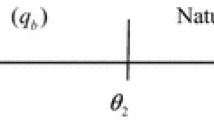Abstract
We analyze credence goods markets in the case of two firms. Consumers know that the quality of the good varies but do not know which firm is of high quality. First, we show that the high quality producer may be unable to monopolize the market, or even to survive in some cases, in situations where it is efficient and trusted by all consumers. Second, although a label restoring full information improves welfare, it may also reduce both firms’ profits by intensifying competition. Since even the high quality producer may not wish to label its product, in such cases the label must be mandatory. Third, an imperfect label which moves everybody’s beliefs closer to the truth without restoring full information may produce adverse results on market structure and welfare, either by increasing or by reducing the variance of beliefs.
Similar content being viewed by others
References
Crespi J.M., Marette S. (2003). Some economic implication of public labeling. Journal of Food Distribution Research 34(3): 83–94
Crespi J.M., Marette S. (2001). How should food safety certification be financed. American Journal of Agricultural Economics 84(4): 852–861
Darby M., Karni E. (1973). Free competition and the optimal amount of fraud. Journal of Law and Economics 16 (1): 67–88
Emons W. (1997). Credence goods and fraudulent experts. Rand Journal of Economics 28(1): 107–119
Emons W. (2001). Credence goods monopolists. International Journal of Industrial Organization 19(3–4): 375–389
Fudenberg D., Tirole J. (1984). The fat cat effect, the puppy dog ploy and the lean and hungry look. American Economic Review, Paper and Proceeding 74(2): 361–368
Fulton M., Giannakas K. (2004). Inserting GM products into the food chain: The market and welfare effects of different labeling and regulatory regimes. American Journal of Agricultural Economics 86(1): 42–60
Gabszewicz J., Grilo I. (1992). Price Competition when Consumers are Uncertain about which firm sells which quality. Journal of Economics and Management Strategy 1(4): 629–649
Garella, P. G., & Petrakis, E. (2008). Minimum quality standards and consumers’ information. Economic Theory (forthcoming).
Lapan H., Moschini G. (2007). Grading, minimum quality standards, and the labeling of genetically modified products. American Journal of Agricultural Economics 89(3): 769–783
Lizzeri A. (1999). Information revelation and certification intermediaries. Rand Journal of Economics 30(2): 214–231
Marette S., Bureau J.C., Gozlan E. (2000). Product safety provision and consumers’ information. Australian Economic Paper 39(4): 426–441
Nelson P. (1970). Information and consumer behaviour. Journal of Political Economy 78(2): 311–329
Palfrey T., Romer T. (1983). Warranties, performance, and the resolution of buyer–seller disputes. Bell Journal of Economics 14(1): 97–117
Roe R., Sheldon I. (2007). Credence good labeling: The efficiency and distributional implications of several policy approaches. American Journal of Agricultural Economics 89(4): 1020–1033
Segerson K. (1999). Mandatory versus voluntary approaches to food safety. Agribusiness 15(1): 53–70
Shapiro C. (1983). Optimal pricing of experience goods. Bell Journal of Economics 14(2): 497–507
Shaked A., Sutton J. (1983). Natural oligopolies. Econometrica 51(5): 1469–1484
Tirole J. (1988). The theory of industrial organisation. Harvard University Press, Cambridge, Mass
Author information
Authors and Affiliations
Corresponding author
Rights and permissions
About this article
Cite this article
Bonroy, O., Constantatos, C. On the use of labels in credence goods markets. J Regul Econ 33, 237–252 (2008). https://doi.org/10.1007/s11149-008-9058-z
Published:
Issue Date:
DOI: https://doi.org/10.1007/s11149-008-9058-z




